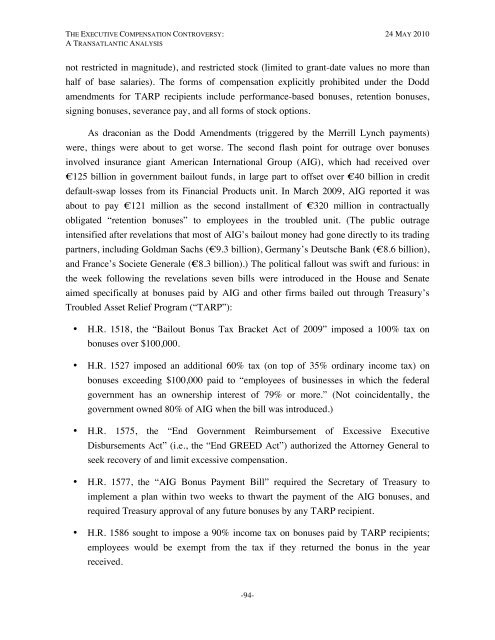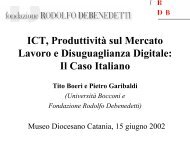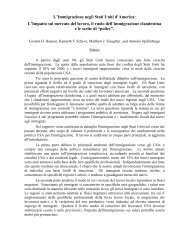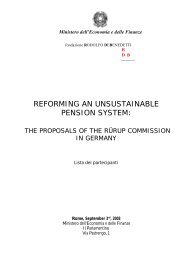The Executive Compensation Controversy - Fondazione Rodolfo ...
The Executive Compensation Controversy - Fondazione Rodolfo ...
The Executive Compensation Controversy - Fondazione Rodolfo ...
You also want an ePaper? Increase the reach of your titles
YUMPU automatically turns print PDFs into web optimized ePapers that Google loves.
THE EXECUTIVE COMPENSATION CONTROVERSY: 24 MAY 2010A TRANSATLANTIC ANALYSISnot restricted in magnitude), and restricted stock (limited to grant-date values no more thanhalf of base salaries). <strong>The</strong> forms of compensation explicitly prohibited under the Doddamendments for TARP recipients include performance-based bonuses, retention bonuses,signing bonuses, severance pay, and all forms of stock options.As draconian as the Dodd Amendments (triggered by the Merrill Lynch payments)were, things were about to get worse. <strong>The</strong> second flash point for outrage over bonusesinvolved insurance giant American International Group (AIG), which had received over€125 billion in government bailout funds, in large part to offset over €40 billion in creditdefault-swap losses from its Financial Products unit. In March 2009, AIG reported it wasabout to pay €121 million as the second installment of €320 million in contractuallyobligated “retention bonuses” to employees in the troubled unit. (<strong>The</strong> public outrageintensified after revelations that most of AIG’s bailout money had gone directly to its tradingpartners, including Goldman Sachs (€9.3 billion), Germany’s Deutsche Bank (€8.6 billion),and France’s Societe Generale (€8.3 billion).) <strong>The</strong> political fallout was swift and furious: inthe week following the revelations seven bills were introduced in the House and Senateaimed specifically at bonuses paid by AIG and other firms bailed out through Treasury’sTroubled Asset Relief Program (“TARP”):• H.R. 1518, the “Bailout Bonus Tax Bracket Act of 2009” imposed a 100% tax onbonuses over $100,000.• H.R. 1527 imposed an additional 60% tax (on top of 35% ordinary income tax) onbonuses exceeding $100,000 paid to “employees of businesses in which the federalgovernment has an ownership interest of 79% or more.” (Not coincidentally, thegovernment owned 80% of AIG when the bill was introduced.)• H.R. 1575, the “End Government Reimbursement of Excessive <strong>Executive</strong>Disbursements Act” (i.e., the “End GREED Act”) authorized the Attorney General toseek recovery of and limit excessive compensation.• H.R. 1577, the “AIG Bonus Payment Bill” required the Secretary of Treasury toimplement a plan within two weeks to thwart the payment of the AIG bonuses, andrequired Treasury approval of any future bonuses by any TARP recipient.• H.R. 1586 sought to impose a 90% income tax on bonuses paid by TARP recipients;employees would be exempt from the tax if they returned the bonus in the yearreceived.-94-









